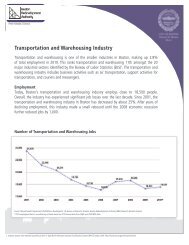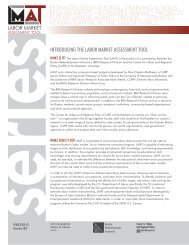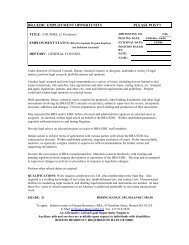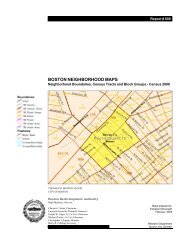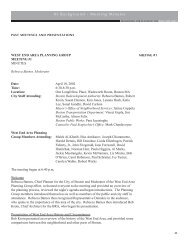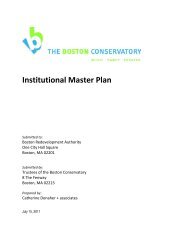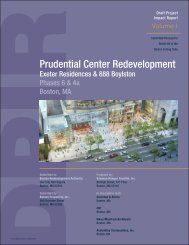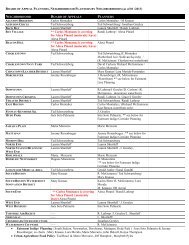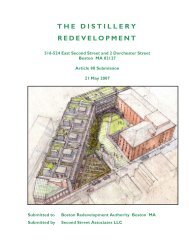point cover jan 13 - Boston Redevelopment Authority
point cover jan 13 - Boston Redevelopment Authority
point cover jan 13 - Boston Redevelopment Authority
Create successful ePaper yourself
Turn your PDF publications into a flip-book with our unique Google optimized e-Paper software.
\\MABOS\projects\1<strong>13</strong>81.00\reports\Article80\<br />
Expanded_PNF\04_Environmental_FINAL.do<br />
c<br />
Vanasse Hangen Brustlin, Inc.<br />
The Point, <strong>Boston</strong><br />
Street, Peterborough Street, Riverway, and Park Drive. The maximum sound levels from the rooftop<br />
mechanical equipment served as a criterion during the selection of the specific rooftop mechanical<br />
equipment. The specifications for the specific rooftop mechanical equipment, with any appropriate mitigation<br />
measures, such as acoustical noise walls, equipment locations, and enclosures will be designed to meet the<br />
calculated maximum sound levels.<br />
The noise analysis also evaluated noise associated with loading activities from the Project. The analysis<br />
examined the building design, such as location of the loading area, and management of deliveries at the<br />
Project Site.<br />
<br />
Receptor Locations<br />
The noise analysis included evaluation of the study area to identify sensitive receptor locations that have<br />
outdoor activities and that might be sensitive to noise associated with the Project. The noise analysis<br />
identified seven sensitive receptor locations in the vicinity of the Project Site. The analysis evaluated the<br />
following receptor locations:<br />
R1 – Trilogy;<br />
R2 – <strong>13</strong>7 Peterborough Street;<br />
R3 – 100 Riverway;<br />
R4 – 449 Park Drive;<br />
R5 – <strong>13</strong>30 Boylston Street;<br />
R6 – <strong>13</strong>8 Peterborough Street; and<br />
R7 – 235 Park Drive.<br />
These receptor locations, selected based on land use considerations, represent the most sensitive locations in<br />
the vicinity of the Project site. Figure 4.5 depicts the receptor locations used in the noise analysis.<br />
<br />
Existing Conditions<br />
A noise monitoring program was conducted to establish existing sound levels. The existing sound levels were<br />
measured using a Type 1 sound analyzer (Larson Davis 824). Measurements were conducted during the<br />
weekday daytime (2:00 PM to 4:00 PM) and late night (11:00 PM to 1:00 AM) periods at sensitive receptor<br />
areas in February 2012. The measured sound level data under existing conditions was dominated by noise<br />
from local roadways (such as Boylston Street and Riverway/Park Drive) and mechanical equipments from<br />
nearby buildings.<br />
The existing measured L90 sound levels range from 54 dB(A) to 58 dB(A) during the daytime period and was<br />
51 dB(A) during the nighttime period. These sound levels are typical of an urban area. The result of the noise<br />
monitoring program indicates that the sound levels within the study area are below the City’s daytime noise<br />
4-32 Environmental Protection



